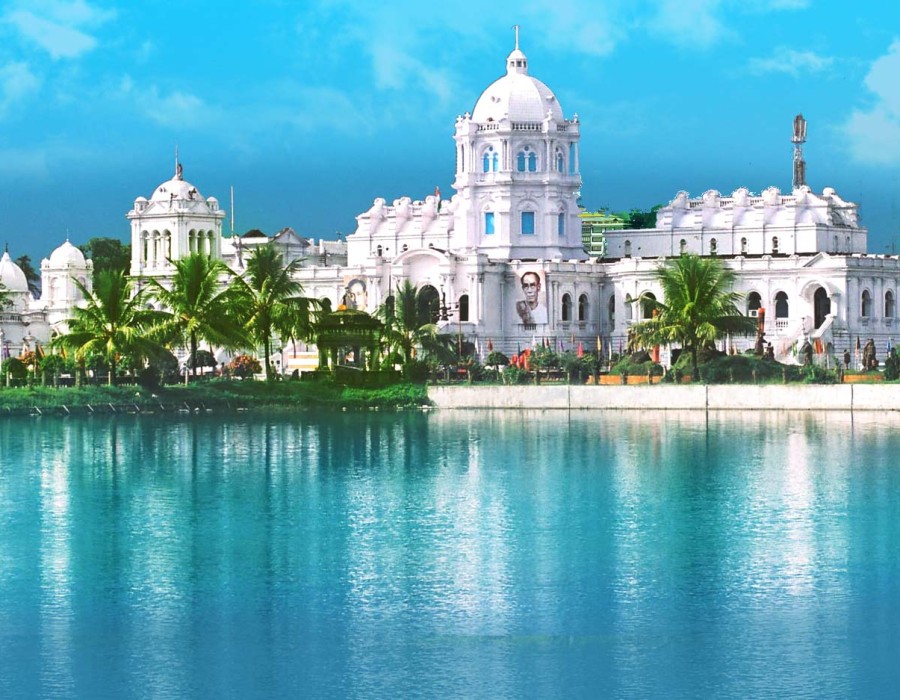Visiting the serene views of Tripura, Neermahal stands as a stunning testament to the state's royal heritage and architectural brilliance. This magnificent water palace, situated on the shimmering Rudrasagar Lake, is an amazing destination that combines natural beauty with rich history, drawing visitors from across the globe.
Historical Significance
Constructed in the 18th century by Maharaja Bir Bikram Kishore Manikya, Neermahal served as a summer retreat for the royal family. The palace was designed not only as a residence but also as a place for leisure and recreation, allowing the royals to escape the heat of the plains. The unique positioning of Neermahal, surrounded by water, adds to its charm and allure, making it a one-of-a-kind structure in India.
The name "Neermahal" translates to "Water Palace," reflecting its picturesque setting. The palace was built using a blend of Mughal and Hindu architectural styles, showcasing intricate carvings and exquisite designs that highlight the craftsmanship of that era. As visitors explore its many rooms, they can admire the ornate pillars, beautiful arches, and breathtaking views that have captivated generations.
Architectural Marvel
Neermahal is an architectural gem, exemplifying the grandeur of royal palaces while harmonizing with the natural surroundings. The palace features a blend of Islamic and Hindu architectural elements, evident in its domes, arches, and decorative motifs. Its three-story structure is adorned with balconies that overlook the lake, providing stunning views that change with the time of day.
The palace is surrounded by lush gardens and manicured lawns, which enhance its beauty and offer a tranquil environment for visitors. The use of red bricks and white marble gives Neermahal a distinctive appearance, making it stand out against the backdrop of the vibrant green hills and the azure lake.
Exploring Neermahal
Visiting Neermahal is an experience that immerses travelers in history, culture, and natural beauty. The journey typically begins with a boat ride across Rudrasagar Lake, which offers a unique perspective of the palace from the water. As you glide across the lake, the reflections of the palace create a magical ambiance, making for memorable photographs.
Once at Neermahal, visitors can explore the various rooms and courtyards of the palace. The royal chambers are adorned with antique furniture and artifacts that provide insight into the lifestyle of the Manikya dynasty. The palace also features a large central courtyard, where cultural events and performances are occasionally held, allowing visitors to experience local traditions firsthand.
For those interested in the local flora and fauna, the area around Neermahal is rich in biodiversity. The lake is home to various species of birds, making it an excellent spot for birdwatching. The surrounding hills are dotted with lush forests, providing ample opportunities for hiking and exploring nature.
Cultural Significance
Neermahal is not just a historical site; it also plays a vital role in the cultural landscape of Tripura. The palace is often a venue for local festivals and events, showcasing the rich traditions of the state. The annual Neermahal Water Festival is one such event, where visitors can enjoy boat races, cultural performances, and traditional music, bringing together people from diverse backgrounds.
The significance of Neermahal extends beyond its architectural beauty; it serves as a reminder of Tripura's royal past and cultural heritage. The palace is a symbol of pride for the people of Tripura, representing the rich history and traditions that have shaped the state over the centuries.
Accessibility and Visitor Information
Neermahal is easily accessible from Agartala, the capital city of Tripura. The distance is approximately 53 kilometers, making it a popular day trip for tourists. Several transportation options are available, including taxis and local buses, which provide convenient access to the palace.
When planning a visit to Neermahal, it is advisable to check the timings, as the palace is open to visitors during specific hours. Guided tours are often available, providing valuable insights into the history and significance of the site.
The best time to visit Neermahal is during the winter months, from October to March, when the weather is pleasant and conducive for exploration. The monsoon season, although lush and vibrant, can lead to flooding in the area, making access challenging.
Tips for Visitors
- Dress Comfortably: Wear comfortable clothing and footwear, as exploring the palace involves walking and climbing stairs.
- Capture the Moments: Bring a camera or smartphone to capture the stunning views of Neermahal and the surrounding landscape.
- Local Cuisine: Don’t miss the opportunity to try local Tripuri dishes at nearby eateries. The rich flavors of the cuisine are a highlight of any trip to the region.
- Respect the Heritage: While exploring the palace, be mindful of the preservation efforts and respect the cultural heritage of the site.
- Stay Hydrated: Carry water, especially if visiting during warmer months, to stay hydrated while exploring.
Conclusion
Neermahal is more than just a palace; it is a window into the rich history and culture of Tripura. With its stunning architecture, picturesque setting, and vibrant cultural significance, a visit to Neermahal promises to be an unforgettable experience. Whether you are a history enthusiast, an architecture lover, or simply someone seeking tranquility amidst nature, Neermahal in Tripura offers something for everyone. Discover the beauty of this majestic water palace and immerse yourself in the enchanting world of Tripura's royal past.





Comments